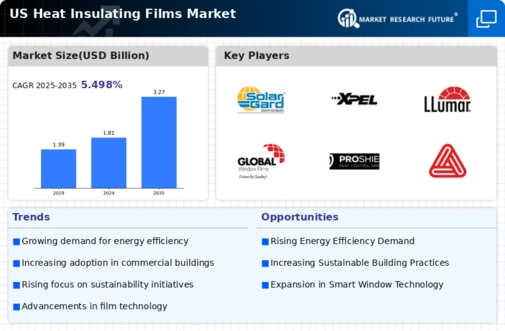The US Heat Insulating Films Market has emerged as a crucial segment within the broader construction and automotive industries, driven by an increasing demand for energy efficiency, sustainability, and enhanced comfort in residential and commercial buildings. The market is characterized by vigorous competition among several key players who are continually innovating and expanding their product lines.
With the growing awareness of environmental issues and the need for energy conservation, numerous companies are dedicated to developing advanced heat insulating films that offer superior thermal performance while delivering aesthetic appeal. The competitive landscape in this market is shaped by factors such as technology advancements, strategic partnerships, and aggressive marketing strategies, which play a pivotal role in gaining market share and customer loyalty.
Ferro is a noteworthy participant in the US Heat Insulating Films Market, known for its strong presence and innovative solutions tailored to meet market demands. The company capitalizes on its deep industry expertise to manufacture high-performance heat insulating films that cater to both commercial and residential applications.
Ferro’s products stand out for their durability and effectiveness in enhancing energy efficiency while blocking harmful UV rays and excessive heat. The company's strength lies in its robust research and development capabilities, allowing it to stay ahead of technological trends and understand customer needs effectively.
Ferro's strategic approach also includes forming partnerships that enhance product offerings while expanding its reach within the US market. These strengths, combined with a focused commitment to sustainability, position Ferro as a formidable player in the competitive landscape of heat insulating films.
Solar Gard operates as another key entity in the US Heat Insulating Films Market, distinguished by its comprehensive range of products designed to provide maximum heat insulation and UV protection. The company offers a diverse portfolio of films that are suitable for various applications, including automotive, residential, and commercial buildings.
Solar Gard’s strength lies in its commitment to quality, backed by years of industry experience and a dedicated focus on innovation. The company has pursued strategic mergers and acquisitions to strengthen its market presence, integrating new technologies and expanding its product lines to meet the evolving needs of customers.
Solar Gard's strategic initiatives ensure its competitiveness in the market, enabling it to deliver high-quality solutions that enhance comfort and energy savings while maintaining a strong foothold in the US Heat Insulating Films Market.



















